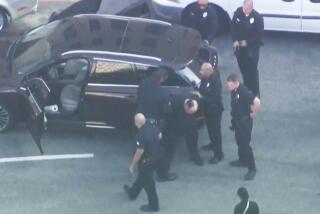DNA FAILS TO FIND SERIAL KILLER
- Share via
The Los Angeles Police Department’s hunt for an elusive serial killer who has stalked women in South L.A. for more than two decades was dealt a setback Tuesday when a controversial search of DNA databases for the killer’s family members came up empty.
“We were hoping,” said LAPD Deputy Chief Charlie Beck, who is overseeing a task force of detectives working to solve the case. “Police work is very much about exploring every avenue. We went down this one and it didn’t turn out to be fruitful.”
Pioneered in Britain, familial DNA searches are largely uncharted territory in the United States. The attempt to identify one of the serial killer’s relatives was the first major use of California’s new familial searching policy, the most far-reaching in the nation. Underscoring the importance of the case, state Atty. Gen. Jerry Brown overcame serious constitutional and privacy concerns raised by advisors and cleared the way for the search.
In leading up to Tuesday’s anticlimax, state officials had painstakingly created a list of possible relatives from the state database of felons’ DNA profiles. They then eliminated potential matches through further genetic testing and by reviewing public records to determine ages, addresses and names of family members. In the end, there were no matches.
The possibility of a match had raised hopes among LAPD detectives that they would catch a break in a case that has stymied the department for years. The task force is now left to continue with ongoing efforts to revive leads from old cases, search for missed clues and hope someone with knowledge of the killer comes forward.
The serial killer has claimed 10 known victims, striking most recently last year. Except for one man, he has targeted young, black women, many of them prostitutes.
He sexually assaults the women and kills them by shooting or strangling them, often leaving their bodies in alleyways along Western Avenue.
The LAPD’s search for the killer has been marred by long stretches of time between known killings and a disjointed, often dormant investigation that spanned different generations of detectives.
The first known attack came in the summer of 1985 at a time when widespread cocaine use, rampant crime and vicious killings were afflicting South L.A. Overwhelmed by the violence, police did not realize they were confronting something larger until three years later, when ballistics tests showed that the same handgun had been used in seven other killings.
In 2004, a genetic sample preserved from one of the old crime scenes matched samples collected from the body of a women killed in 2003 and a 14-year-old girl killed the year before. Police used DNA to link the killer to another murder in January 2007.
Investigators ran the killer’s DNA against millions of genetic profiles of convicted criminals in law enforcement databases, but found nothing.
Hoping that the killer’s father or brother was in the database, the LAPD then pushed for the state to use the more complex familial search.
The odds were stacked against them. State officials put the chances of finding the serial killer through a relative at about one in 10.
Mitchell Morrissey, the district attorney in Denver who prodded California officials to do familial searching, applauded the LAPD and state officials for trying. He urged the FBI, which maintains national DNA databases, to lift its ban on doing familial searches in them. “This murderer may have a relative in a DNA database in another state,” he said.
--
maura.dolan@latimes.com
Times staff writer Jason Felch contributed to this report.
More to Read
Sign up for Essential California
The most important California stories and recommendations in your inbox every morning.
You may occasionally receive promotional content from the Los Angeles Times.















